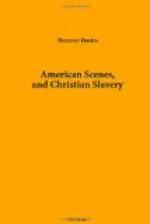The next was a black boy, 16 years of age. He mounted the chair, not the platform. “Now, gentlemen, here is an excellent ploughboy. Who bids for him? Thank you,—400 dollars bid for him—425,” and so on to 550 dollars. “Why, look at him; he is a powerful-limbed boy; he will make a very large strong man.” He was knocked down at 625 dollars.
“The next I have to put up, gentlemen, is a young piece of city goods—the girl Cornelia. She is 18 years of age, a good washer and ironer, but not a very good cook. She is well known in the city, and has always belonged to some of the best families.” By this time Cornelia was standing upon the chair. “Now, gentlemen, who bids for this girl? She is sold for no fault, but simply for want of money. Who bids for this excellent washer and ironer?” At this moment one of the “gentlemen,” standing in front of her, deliberately took his walking-stick, and, with the point of it, lifted up her clothes as high as the knee. I afterwards saw this same man walking arm-in-arm with his white wife in the street. “500 dollars offered for her—530 dollars.” She went for 580.
Here let me state, once for all, that I took notes on the spot. Those around me no doubt thought I was deeply interested in the state of the slave-market, and wishful to convey the most accurate information to my slave-breeding and soul-driving correspondents at a distance. Had my real object and character been discovered, I gravely doubt whether I should have left that “great” and “free” city alive!
The next “lot” were Jim, his wife, and two children, one about three, and the other about two years of age,—all on the platform. They were said to be excellent cotton-field hands, title good, and so forth; but, somehow, there were no bidders.
A boy about ten years of age, a fine intelligent-looking little fellow, was now made to mount the chair. “Now, who bids for Tom? an excellent house-boy, a ‘smart’ young lad; can wait well at table—title good—guaranteed free from all the vices and maladies provided against by law. Who bids for him?” The bidding began, at 350 dollars, and ended at 425.
“I have now to put up the boy Edmund, thirty-two years of age, an excellent cotton-field hand. Who bids for the boy Edmund?” At this moment a gentleman, who, like most of those present, appeared to be a sort of speculator in slaves, stepped forward, and examined with his hands the boy’s legs, especially about the ankles, just as I have seen horse-dealers do with those animals at fairs. There were, however, no bidders; and Edmund was put down again.




